

Food Security. Water Shortages May Leave Energy Producers Dying of Thirst. Water Shortages May Leave Energy Producers Dying of Thirst. Geopolitics and energy.
Bibliography: Energy Security Foresight. Pearltrees: a multifunction visual bibliographic tool. While preparing the bibliography on energy security foresight, I was wondering if it would be useful to also apply a visually appealing approach to bibliographies, which would then be conceptualized as a product.

As usual, there is no simple answer to this question, and if the classical bibliography will most probably have to be kept for a while, Pearltrees also appears as a perfect bibliographic tool. Because delivery of product must consider both the product’s material support and the recipient or customer, then the traditional way to write a bibliography will probably have to be kept for some time. SF&W the case of energy security. Energy Scenarios - Millenium Project. Millennium Project 2020 Global Energy Scenarios Introduction Abstract of the Scenarios Scenario 1.
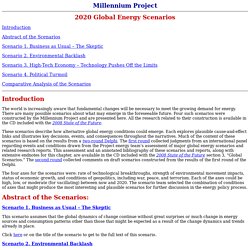
PERSPECTIVE: Cultivating Strategic Foresight for Energy and Environmental Security. PERSPECTIVE: Cultivating Strategic Foresight for Energy and Environmental Security David A.

Bray, Sean Costigan, Keith A. Daum c1, Helene Lavoix, Elizabeth L. Malone and Chris Pallaris. A review of the Citigroup Prediction on US Energy. North American shale plays (EIA map, cited by Citigroup) The image projected by the above figure suggests that the country is covered in shale, all waiting to provide its wealth to the nation.
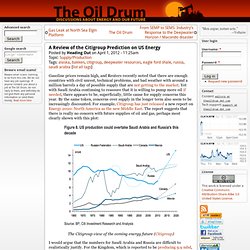
But that is not the case and shale plays have been a hot topic for a number of years now. And while the map above shows a carpet of shale that has the potential to produce oil and/or natural gas, it does not clearly enough distinguish the considerable difference between deposits that are presently economic, and those that are not. (The small number of fields that are labelled as prospective does not speak well for the future).
If one examines the prediction for future production, it shows that overall US growth in production of all liquids will rise from some 9 mbd at the end of 2011 to 11.6 mbd in 2015, and then go on to a figure of 15.6 mbd in 2020. Projected growth in US production (Citigroup ) La fin d'un modèle. Fondée depuis deux siècles sur l’utilisation croissante de ressources historiquement considérées comme infinies (ce qui se retrouve dans les bases de l’économie classique), notre économie bute désormais de manière répétée sur les limites physiques de la planète.
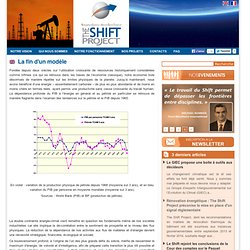
Jusqu’à maintenant, nous avons bénéficié d’une énergie – essentiellement carbonée – de plus en plus abondante et de moins en moins chère en termes réels, ayant permis une productivité sans cesse croissante du travail humain. La dépendance profonde du PIB à l’énergie en général et au pétrole en particulier se retrouve de manière flagrante dans l’examen des tendances sur le pétrole et le PIB depuis 1965. En violet : variation de la production physique de pétrole depuis 1968 (moyenne sur 3 ans), et en bleu : variation du PIB par personne en moyenne mondiale (moyenne sur 3 ans).
A perspective from the demand side (OSINT analysis) The Efficiency Paradox. CIBC - World Market. Rebound effect. Definition and Implications of the Rebound Effect.
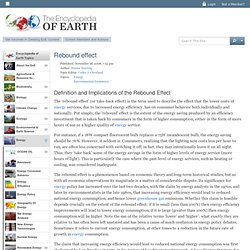
UK energy sector indicators. World Energy Outlook (IEA) Alternative Fuels for Military Applications. The U.S.
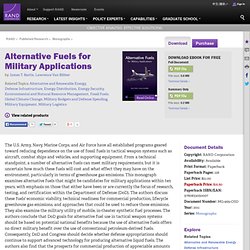
Army, Navy, Marine Corps, and Air Force have all established programs geared toward reducing dependence on the use of fossil fuels in tactical weapon systems such as aircraft, combat ships and vehicles, and supporting equipment. From a technical standpoint, a number of alternative fuels can meet military requirements, but it is uncertain how much these fuels will cost and what effect they may have on the environment, particularly in terms of greenhouse gas emissions. This monograph examines alternative fuels that might be candidates for military applications within ten years, with emphasis on those that either have been or are currently the focus of research, testing, and certification within the Department of Defense (DoD).
The authors discuss these fuels' economic viability, technical readiness for commercial production, lifecycle greenhouse gas emissions, and approaches that could be used to reduce those emissions. Fueling the "Balance": A Defense Energy Strategy Primer. Introduction The U.S.
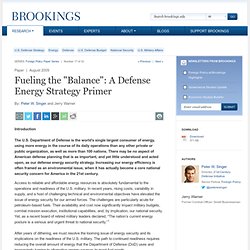
Department of Defense is the world’s single largest consumer of energy, using more energy in the course of its daily operations than any other private or public organization, as well as more than 100 nations. There may be no aspect of American defense planning that is as important, and yet little understood and acted upon, as our defense energy security strategy. Increasing our energy efficiency is often framed as an environmental issue, when it has actually become a core national security concern for America in the 21st century. Access to reliable and affordable energy resources is absolutely fundamental to the operations and readiness of the U.S. military.
DoDFuelCell ERDC-CERL Projects. The Alternative Energy Matrix (The Oil Drum) The Matrix Would you like to know what the matrix is?
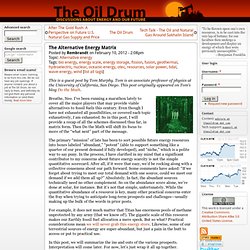
Okay. I’ll tell you—in a bit. For each of the major energy hopefuls I have discussed on Do the Math, I characterize their various attributes in a three-tier classification: adequate (green); marginal (yellow); or insufficient (red)—possibly a showstopper. The scheme is qualitative, and I am sure some will disagree with my assignments. Okay, I’ll keep the suspense going a bit by describing the fields. Abundance: This is essentially the “abundant,” “potent,” and “niche” classification scheme reflected in the preceding posts. Difficulty: This field tries to capture the degree to which a resource brings with it large technical challenges. Intermittency: Green if rock-steady or there whenever we need it. The Alternative Energy Matrix. 4 views this month; 0 overall Breathe, Neo.
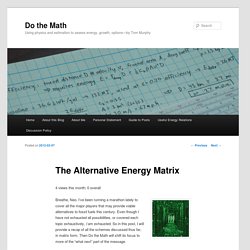
I’ve been running a marathon lately to cover all the major players that may provide viable alternatives to fossil fuels this century. Even though I have not exhausted all possibilities, or covered each topic exhaustively, I am exhausted. Post Index. Not all posts are the same quality or have the same impact. If you are new to Do the Math, I recommend the following paths. A chronological list appears at the bottom.
Growth and Sustainability.